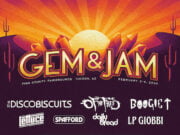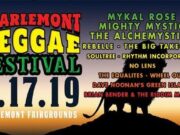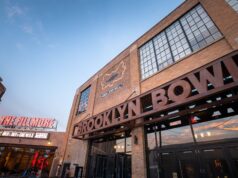
Nestled in the Pocono Mountains of Eastern Pennsylvania is a small town made famous by changing their town’s name to honor one of America’s greatest athletes, Jim Thorpe. Though he was not from there, the town was inspired by his accomplishments and took his name. In the late 1800s when the area was still known as Mauch Chunk, the community came together and decided to build a building for community events, town hall, and local market. Over the years that building has been renovated many times and is the current Opera House for the area. As not too many operas are heading through NEPA, for decades it has housed concerts for the community.
We spent some time with Dan Hugos, one of the folks involved with the operation and promotion of the Mauch Chunk Opera House, and asked him all about the venue, and their vision in terms of bringing music into the historic venue. Along with his partners, Vincent DeGiosio and Christie McGorry, they run a company called JTAMS productions who are responsible for throwing the concerts at the Opera House.
(Check out some really cool video of Enter the Haggis at the Opera House for their drummer’s final show in September of 2010 in the video section below. )
Live Music News and Review: Tell us a bit about the history of Mauch Chunk Opera House.
Dan Hugos: The Opera House was opened in the winter of 1882 as a Vaudeville theater. It had two floors: upstairs was the theater and downstairs was used as a public market where farmers would congregate to sell to the townspeople. This was in the days before food stores. Upstairs at the theater acts like Mae West, Al Jolson, John Phillip Sousa, and the Dorsey Brothers, along with traveling theater groups visited regularly. The market was removed in 1925 and the second floor converted into the balcony section that you see today. By the Fifties, most of the Coal Money in the area had left own and Opera House closed. It re-opened in the late Seventies, and since 2003 the focus has been mostly on live music, though we occasionally feature some theater, film and contemporary dance. In recent years we’ve replaced the (130 year-old) roof, the seating and totally upgraded the sound and our backstage facilities. Now we handle about 375 people, and all seats are close to the action because we have a balcony rather than a single floor.
LMN&R: We have also noticed that you are getting into some more progressive music at the Mauch Chunk Opera House. What is your musical mission?
Our main mission is to find and market acts that we can afford and which will compel people to travel here to see a show. Our average customer travels between 40 and 50 miles to come here. Their whole experience absolutely has to be good or they’re not making that drive again. They have options. In the context of putting on a regular program of 50-60 shows a year, this is a major challenge. So we have to provide a variety of quality acts spanning rock, singer-songwriter, jazz, fusion, big band, classical and occasionally opera.
LMN&R: What makes Eastern PAand Jim Thorpe unique for musicians and fans?
When I first visited Jim Thorpe in 1998, I had the immediate sense of a town that people could enjoy for a day or a weekend before then finding cool things to do at night. The town has changed so much since then, in so many positive ways. We’re less than an hour and a half from Philly and only two from New York, so we’re an easy getaway. You can ride or hike nice trails, take cool raft trips, swim at the nearby lake, check out a surprising variety of shops, galleries, restaurants and pubs. Then you can walk up the street and see a great show in a relaxed environment. We’re the anti-city experience. For performers, I always suggest to them that playing a venue like this will hopefully remind them of why they got into the music business in the first place: they’re going to sound great. It’s not a mosh-pit here: audiences come to hear and experience whoever is onstage.

LMN&R: What are some of your favorite musical memories that have happened at the venue?
I recall the first time the Canadian vocal group The Wailin’ Jennys performed here in 2006. I had just introduced them and was walking away from the stage when the power suddenly went off, causing an instant commotion. Looking outside I saw that the whole town was without power, so I went back onstage and discussed with the Jennys what to do. They were totally cool about the situation, they’re the consummate professionals. They just stepped forward and did a cappella tunes while the place dimly glowed from the emergency lights. The power came back about 15 minutes later and the Jennys got a standing ovation, essentially to begin their show. I’ll never forget that. Then, three years later, they recorded their live album here at the Opera House – one show, one take, twelve phenomenal tracks. I’ll never forget that either.
Another that comes to mind was in September, 2008 when the Billy Cobham Spectrum Band stayed in town for four days before playing the Opera House. I had seen him when I was 16, as the drummer for the Mahavishnu Orchestra with John McLaughlin. I had always dreamed about bringing an act of that caliber to the Opera House, and after years of trying, we succeeded! One afternoon while listening to the band rehearse I realized I was the only person in the venue at the time. Not only was Cobham onstage, but also Tom Coster from Santana, Victor Bailey from Weather Report, and Dean Brown from David Sanborn Group. I completely savored that moment, and then what an earthquake of a show they brought to the actual show – pure power and total virtuosity.
LMN&R: How is the modern world of social networking and technology being brought in to your marketing efforts for shows?
Our core technological tools are our website and email marketing. We’ve re-designed our site four times since 2003. It is so important to be constantly collecting new contacts and keeping in touch with them. We are also on Facebook, a very useful medium because its format is so simple and easy to use. It is also a valuable advertising tool because it helps you define campaigns that reach customers who are interested in particular shows and in specific geographic areas, while letting you set your budget. We also continue to be heavily involved in more traditional PR efforts with newspapers and radio stations. We always help public radio stations raise money by lining up show-dinner-accommodations packages that raise money for them. We also work a nearby festival called MusikFest which is great for our visibility as a couple million people attend it each year. All these tools help us keep it fresh here, which is all-important.
LMN&R: What are some of the challenges here in the new millennium in terms of promoting theater sized shows?
There are so many distractions for people and so many options that your obstacles are not only the similar venues in the region. They are everything from renting movies at home to relaxing over dinner to just about anything. Live performance is realistically just another option for people. Add to that the fact that most of our audience drives a good distance to get here, and you have a big challenge. This is why I’ve been so involved in our local Chamber of Commerce, and so involved in marketing the town of Jim Thorpe as a whole, as well as its individual attractions. Our challenge is to make potential customers think of Jim Thorpe and the Opera House as cool, very unique places that are totally different from what they normally experience. We also want them to realize we’re very close to wherever they live.
LMN&R: If you had the ability to book anyone ever into the Opera House, what would your dream show be?
The first name that comes to mind is John McGlaughlin and I’m trying. Another would be The Old Crow Medicine Show. But there are so many others, and I hope they’re not all dreams!
LMN&R: What about your personal history and work history has brought you to this job at Mauch Chunk Opera House?
I had no experience with performance venues prior to 2003 before starting our company here at the Opera House. I did however, have a lifelong love of live music starting from the first show I ever saw, which was T. Rex and Mountain at the Fillmore East. I’ve also had a lot of experience in business, computer systems, and customer service – all absolutely key components if you’re going to have a chance. If I gave you all the particulars of my job description, you might wonder why I do it, but I love it. I am also very fortunate to work with business partners who are very talented and resourceful producers and designers. As performers themselves, they are able to establish working relationships with the performers that help us put on the best show possible.

LMN&R: In your opinion, what are some of the things that you have seen bands dothat really made their shows succeed?
The main thing is how well a band bonds to an audience. At the Opera House, every seat is close and even the most off-putting performer is almost forced to relate to the audience, and they always do. When people come for live music, they accept that the performer does it for a living, but they need to feel that sincerity and authenticity as well. When performers establish this connection, not only do they keep audiences coming back, but they sell a lot of merchandise. We have the phenomenal guitarist and vocalist Willy Porter here regularly. He said to me once that when you sell an audience member a CD after the show, you’re essentially selling them what they already paid for. Which leads me to my second point – you can never develop enough business awareness. All successful musicians constantly work at it.
LMN&R: What are some of the things that bands should definitely avoid doing to make their shows more successful?
Change is good, but you need to feel it, otherwise you’ll lose your audience. If a band has a publicist, they have to keep tabs on them and make sure they’re actually doing their thing with local media outlets wherever they play. You can’t avoid the business aspect of the music industry, in fact, a band has to embrace it and get good at it. Don’t put out crappy support material or websites. Communicate with your management and booking agent.
LMN&R: What is different about the Opera House?
The first time we ever produced a show here back in 2003, I thought of that first show at the Fillmore East that I mentioned before. That was in 1971 and in those days; people generally sat back and took a show in, no matter what it was. They really experienced the show and in that spirit I experienced great shows early on. I immediately had the sense that we could do that here at the Opera House on a regular basis. It felt like that kind of venue despite the shortcomings it had back then, most of which we’ve addressed. And because of that, I had the hope that great performers would all want to play here (and press their management companies to make it happen). We have plenty of places to dance and stand and take in the show, but essentially it’s a listening room, where you can meet the performer afterwards, and generally hang out in a very relaxed environment that is staffed by nice, dedicated people. You never get herded in and out because there’s a second show. It’s meant to be all the good things about performance that we’ve all experienced. After the show, we want people to think they just had a very cool, memorable time.













































